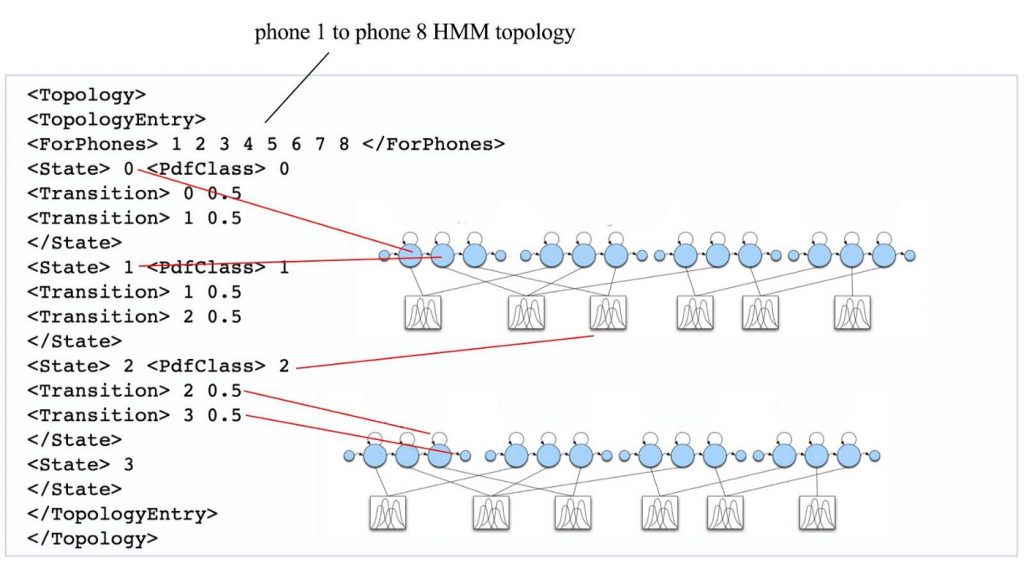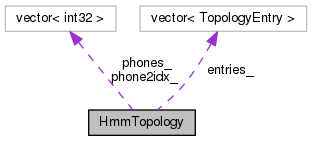Kaldi中的topo结构
Kaldi中的topo结构,在每个样例中是以topo文件表示,在代码中是由HmmTopology这个类表示,拓扑结构中的参数的更新会在TransitionModel这个类体现出来。
下面是Kaldi中yesno样例下面的topo文件,文件位置:
egs/yesno/s5/data/lang/topo
这个文件是由utils/gen_topo.pl生成,而这个脚本是在utils/prepare_lang.sh中调用,prepare_lang.sh在run.sh中被调用。run.sh这个脚本就是我们用来train模型的。
<Topology>
<TopologyEntry>
<ForPhones>
2 3
</ForPhones>
<State> 0 <PdfClass> 0 <Transition> 0 0.75 <Transition> 1 0.25 </State>
<State> 1 <PdfClass> 1 <Transition> 1 0.75 <Transition> 2 0.25 </State>
<State> 2 <PdfClass> 2 <Transition> 2 0.75 <Transition> 3 0.25 </State>
<State> 3 </State>
</TopologyEntry>
<TopologyEntry>
<ForPhones>
1
</ForPhones>
<State> 0 <PdfClass> 0 <Transition> 0 0.25 <Transition> 1 0.25 <Transition> 2 0.25 <Transition> 3 0.25 </State>
<State> 1 <PdfClass> 1 <Transition> 1 0.25 <Transition> 2 0.25 <Transition> 3 0.25 <Transition> 4 0.25 </State>
<State> 2 <PdfClass> 2 <Transition> 1 0.25 <Transition> 2 0.25 <Transition> 3 0.25 <Transition> 4 0.25 </State>
<State> 3 <PdfClass> 3 <Transition> 1 0.25 <Transition> 2 0.25 <Transition> 3 0.25 <Transition> 4 0.25 </State>
<State> 4 <PdfClass> 4 <Transition> 4 0.75 <Transition> 5 0.25 </State>
<State> 5 </State>
</TopologyEntry>
</Topology>
上面

上面的概率0.25, 0.75是 utils/gen_topo.pl中给的一个初始的概率。每一个样例中topo文件中这些概率都是一样的,我们可以看另外一个例子,
<Topology>
<TopologyEntry>
<ForPhones>
21 22 23 24 25 26 27 28 29 30 31 32 33 34 35 36 37 38 39 40 41 42 43 44 45 46 47 48 49 50 51 52 53 54 55 56 57 58 59 60 61 62 63 64 65 66 67 68 69 70 71 72 73 74 75 76 77 78 79 80 81 82 83 84 85 86 87 88 89 90 91 92 93 94 95 96 97 98 99 100 101 102 103 104 105 106 107 108 109 110 111 112 113 114 115 116 117 118 119 120 121 122 123 124 125 126 127 128 129 130 131 132 133 134 135 136 137 138 139 140 141 142 143 144 145 146 147 148 149 150 151 152 153 154 155 156 157 158 159 160 161 162 163 164 165 166 167 168 169 170 171 172 173 174 175 176
</ForPhones>
<State> 0 <PdfClass> 0 <Transition> 0 0.75 <Transition> 1 0.25 </State>
<State> 1 <PdfClass> 1 <Transition> 1 0.75 <Transition> 2 0.25 </State>
<State> 2 <PdfClass> 2 <Transition> 2 0.75 <Transition> 3 0.25 </State>
<State> 3 </State>
</TopologyEntry>
<TopologyEntry>
<ForPhones>
1 2 3 4 5 6 7 8 9 10 11 12 13 14 15 16 17 18 19 20
</ForPhones>
<State> 0 <PdfClass> 0 <Transition> 0 0.25 <Transition> 1 0.25 <Transition> 2 0.25 <Transition> 3 0.25 </State>
<State> 1 <PdfClass> 1 <Transition> 1 0.25 <Transition> 2 0.25 <Transition> 3 0.25 <Transition> 4 0.25 </State>
<State> 2 <PdfClass> 2 <Transition> 1 0.25 <Transition> 2 0.25 <Transition> 3 0.25 <Transition> 4 0.25 </State>
<State> 3 <PdfClass> 3 <Transition> 1 0.25 <Transition> 2 0.25 <Transition> 3 0.25 <Transition> 4 0.25 </State>
<State> 4 <PdfClass> 4 <Transition> 4 0.75 <Transition> 5 0.25 </State>
<State> 5 </State>
</TopologyEntry>
</Topology>
对于上面的topo,除了静音因素,还有其他,总共加起来20,这些包括,笑的因素,杂音,oov。可以通过查看 data/lang/phones.txt这个文件
<eps> 0
sil 1
sil_B 2
sil_E 3
sil_I 4
sil_S 5
laughter 6
laughter_B 7
laughter_E 8
laughter_I 9
laughter_S 10
noise 11
noise_B 12
noise_E 13
noise_I 14
noise_S 15
oov 16
oov_B 17
oov_E 18
oov_I 19
oov_S 20
下面看下HmmTopology

class HmmTopology {
public:
/// A structure defined inside HmmTopology to represent a HMM state.
struct HmmState {
int32 forward_pdf_class;
int32 self_loop_pdf_class;
std::vector<std::pair<int32, BaseFloat> > transitions;
<pre><code>HmmState(): forward_pdf_class(-1), self_loop_pdf_class(-1) { }
HmmState(int32 i): forward_pdf_class(i), self_loop_pdf_class(i) { }
</code></pre>
};
/// TopologyEntry is a typedef that represents the topology of
/// a single (prototype) state.
typedef std::vector<HmmState> TopologyEntry;
void Read(std::istream &is, bool binary);
void Write(std::ostream &os, bool binary) const;
/// Returns the topology entry (i.e. vector of HmmState) for this phone;
/// will throw exception if phone not covered by the topology.
const TopologyEntry &TopologyForPhone(int32 phone) const{
return entries_[phone2idx_[phone]];
}
HmmTopology() {}
private:
std::vector<int32> phones_; // list of all phones we have topology for. Sorted, uniq. no epsilon (zero) phone.
std::vector<int32> phone2idx_; // map from phones to indexes into the entries vector (or -1 for not present).
std::vector<TopologyEntry> entries_;
};
phones_存放了音素,phone2idx是个索引表,根据这个索引表,能找到音素的拓扑结构。通过阅读上面的TopologyForPhone函数可以清楚看出其作用。entries_存放了具体的拓扑结构。就像上面的例子一样,2个音素的拓扑结构是一模一样的,所以entries_中,只要存放一份拓扑结构就可以了,这个是所有音素共享的。
topo的文件的内容会作为初始训练的模型,比如我们查看yesno下面的单因素训练的第一个模型 0.mdl。
我们使用 kaldi查看文件的工具提到命令将这个二进制文件转换成文本文件
$> gmm-copy --binary=false exp/mono0a/0.mdl 0.mdl.txt
LOG (gmm-copy[5.5.896~1-8a59]:main():gmm-copy.cc:75) Written model to 0.mdl.txt
下面是得到0.mdl.txt文件的头部内容,
<TransitionModel>
<Topology>
<TopologyEntry>
<ForPhones>
2 3
</ForPhones>
<State> 0 <PdfClass> 0 <Transition> 0 0.75 <Transition> 1 0.25 </State>
<State> 1 <PdfClass> 1 <Transition> 1 0.75 <Transition> 2 0.25 </State>
<State> 2 <PdfClass> 2 <Transition> 2 0.75 <Transition> 3 0.25 </State>
<State> 3 </State>
</TopologyEntry>
<TopologyEntry>
<ForPhones>
1
</ForPhones>
<State> 0 <PdfClass> 0 <Transition> 0 0.25 <Transition> 1 0.25 <Transition> 2 0.25 <Transition> 3 0.25 </State>
<State> 1 <PdfClass> 1 <Transition> 1 0.25 <Transition> 2 0.25 <Transition> 3 0.25 <Transition> 4 0.25 </State>
<State> 2 <PdfClass> 2 <Transition> 1 0.25 <Transition> 2 0.25 <Transition> 3 0.25 <Transition> 4 0.25 </State>
<State> 3 <PdfClass> 3 <Transition> 1 0.25 <Transition> 2 0.25 <Transition> 3 0.25 <Transition> 4 0.25 </State>
<State> 4 <PdfClass> 4 <Transition> 4 0.75 <Transition> 5 0.25 </State>
<State> 5 </State>
</TopologyEntry>
</Topology>
<Triples> 11
...
...
...
可以看到它就是前面的看到topo文件的内容。






